Hiroshima-style Okonomiyaki is a Japanese savory pancake layered with yakisoba noodles, fried egg, and pork belly drizzled with a delicious sauce. Watch my video tutorial for step-by-step instructions on how to make this fantastic homemade recipe for lunch or dinner!
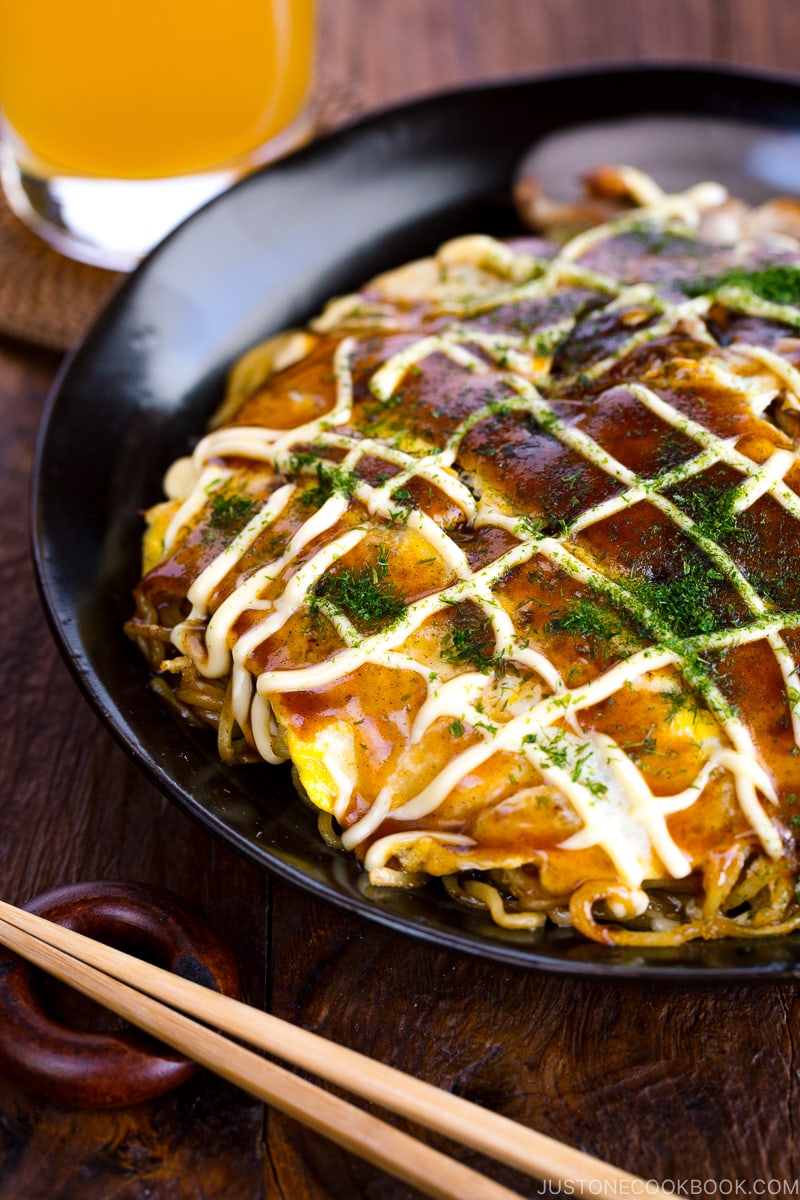
Have you tried Okonomiyaki (お好み焼き) before? It’s a Japanese savory pancake that contains a variety of ingredients. “Okonomi” in Japanese means “as you like it”, so it’s a savory pancake that contains whatever ingredients you like.
Hiroshima-style Okonomiyaki (広島風お好み焼き) is a type of Okonomiyaki that originated in Hiroshima, Japan.
Table of Contents
Two Styles of Okonomiyaki
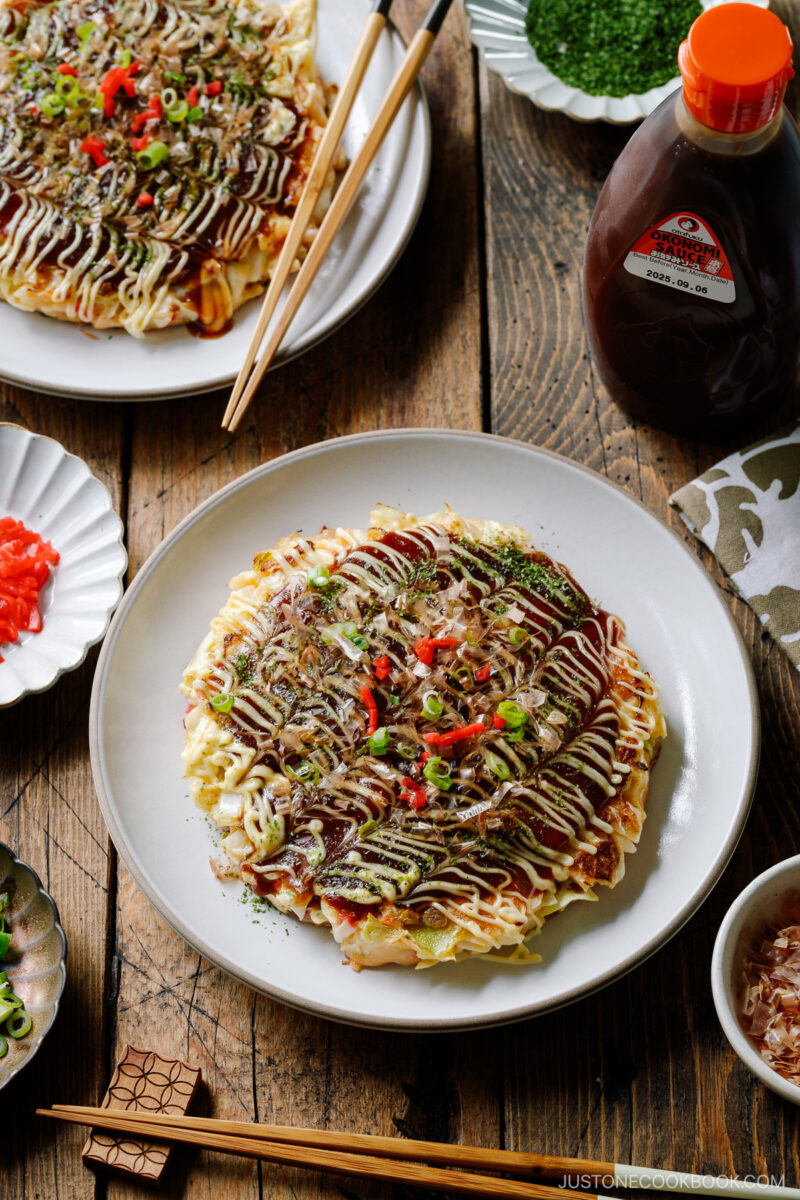

- Osaka-style okonomiyaki – This savory pancake is made of batter, which includes flour and water or dashi, shredded cabbage, egg, and green onion along with the protein of your choice, such as pork belly slices or seafood. You can find my Osaka-style okonomiyaki recipe here.
- Hiroshima-style Okonomiyaki – This savory pancake uses almost the same ingredients, but they are layered rather than mixed in with the batter like Osaka-style. Not only that, fried egg and yakisoba noodles (or sometimes udon noodles) are used as toppings.
Which one is tastier? Well, that’s really up to your preference. If you like fried noodles and a less doughy texture, Hiroshima okonomiyaki is your choice!
I like both styles of okonomiyaki, so it’d be very hard for me to pick just one! At home, I just cook them alternatively.
What is Hiroshima-style Okonomiyaki?
Hiroshima-style okonomiyaki has been around since the 1950s. At that time, the country was quite poor and people only used a little bit of flour and vegetables to make Hiroshima-style okonomiyaki.
The current Hiroshima Okonomiyaki with meat, egg, and noodles is a version that has evolved throughout the years. Nowadays there are over 2,000 restaurants within the Hiroshima area that specialize in Hiroshima-style okonomiyaki!
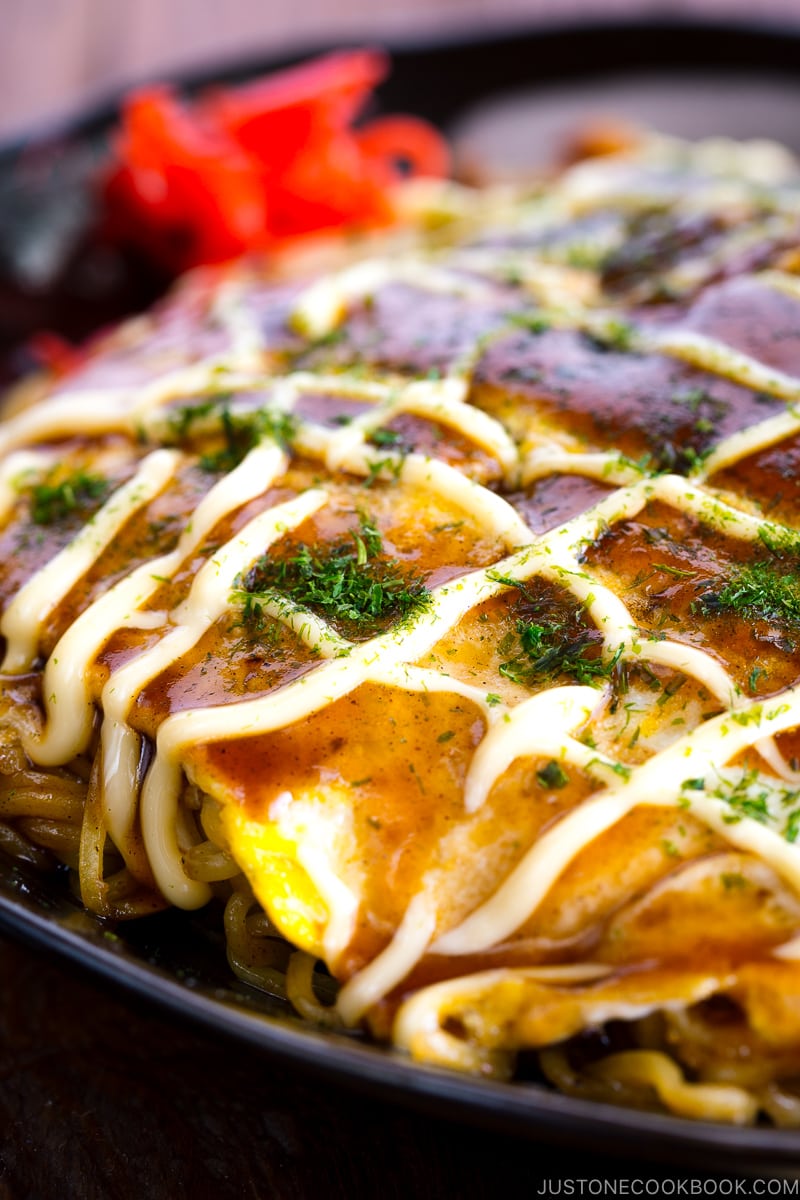
3 Key Toppings for Okonomiyaki
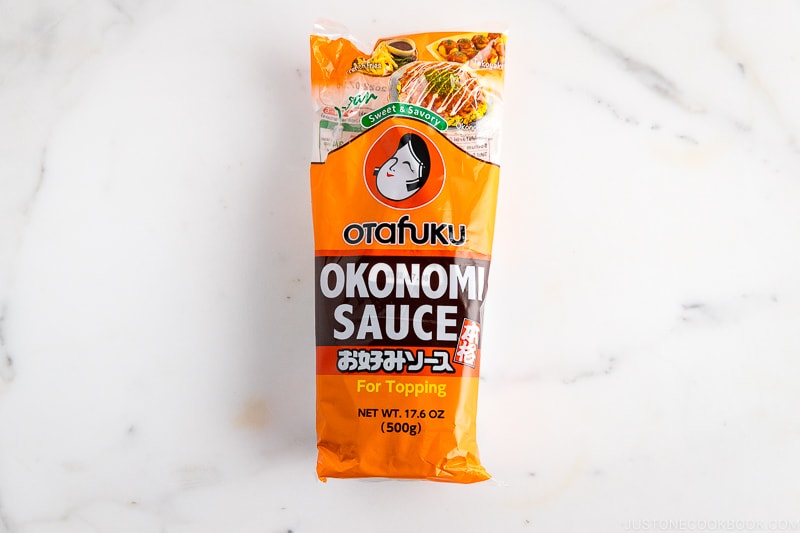
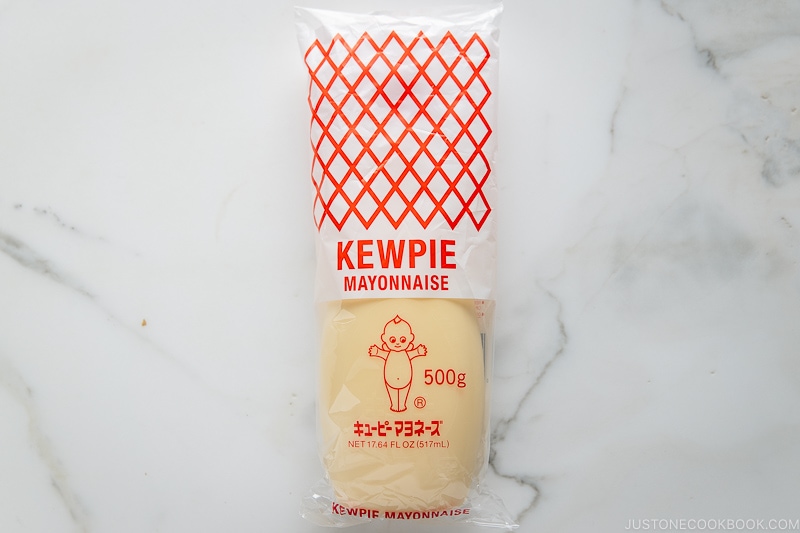
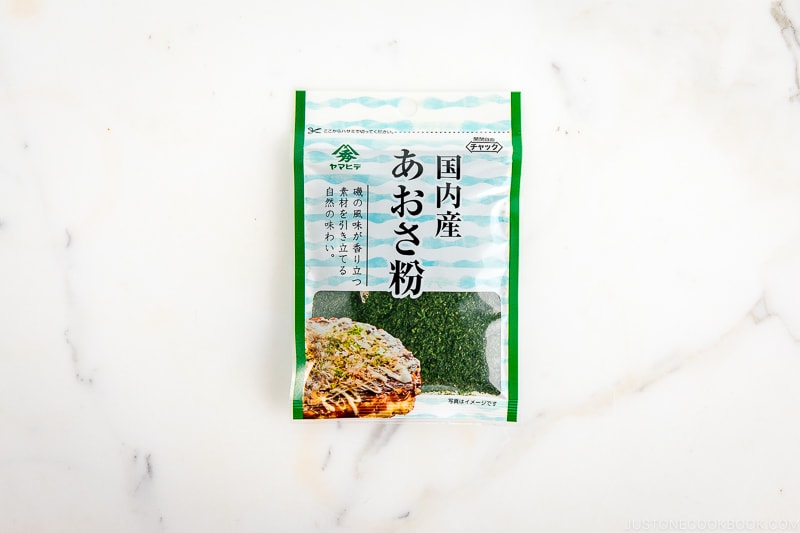
- Okonomi Sauce – I would say the important and delicious element for both Hiroshima- and Osaka-style okonomiyaki is the Okonomi Sauce (お好みソース). Originally, Worcestershire sauce was used but throughout the years the flavor has evolved to the current flavor. Okonomi Sauce has a sweet and sour flavor that’s slightly different from Tonkatsu Sauce and it’s thicker consistency so it goes well with Okonomiyaki. Oh so delicious!
- Japanese Kewpie Mayonnaise – It has a sweet and tangy flavor that is well-balanced. Many JOC readers have told me that they haven’t gone back to the original mayo they had been using since they tasted Japanese mayonnaise!
- Aonori (dried green seaweed) – It is dried green (Ao) seaweed (Nori) flakes/powder. This umami-rich seaweed has a bright intense green color and has a unique fragrant. Japan has many types of seaweed from wakame, nori, to kombu. We use s specific name for each type of seaweed instead of just calling them “seaweed”. It helps identify which is the correct seaweed for a different type of dishes. You can buy Aonori from Amazon and Japanese/Asian grocery stores. Or you can substitute with regular nori if you can’t find it.
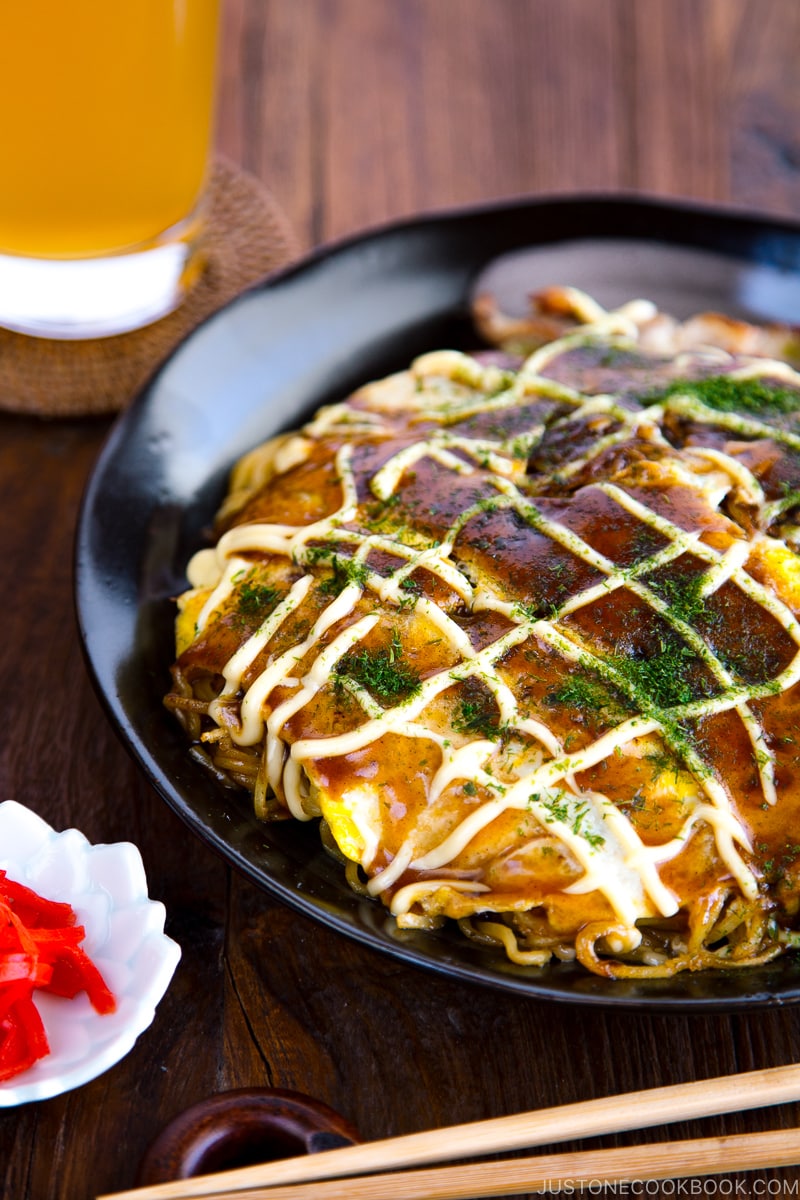
Itadakimasu!
I hope my tutorial video and step-by-step instructions with pictures will help you achieve the delicious Hiroshima-style Okonomiyaki! If you haven’t tried Osaka-style, give it a try next!
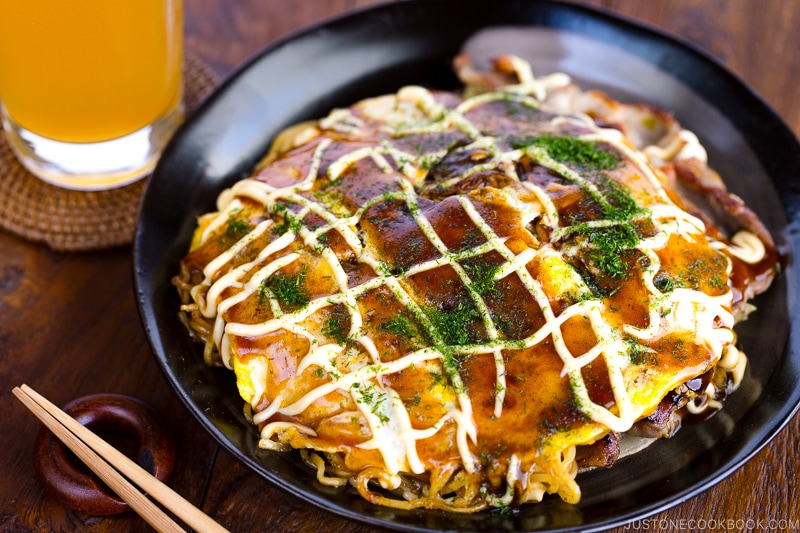
Wish to learn more about Japanese cooking? Sign up for our free newsletter to receive cooking tips & recipe updates! And stay in touch with me on Facebook, Pinterest, YouTube, and Instagram.
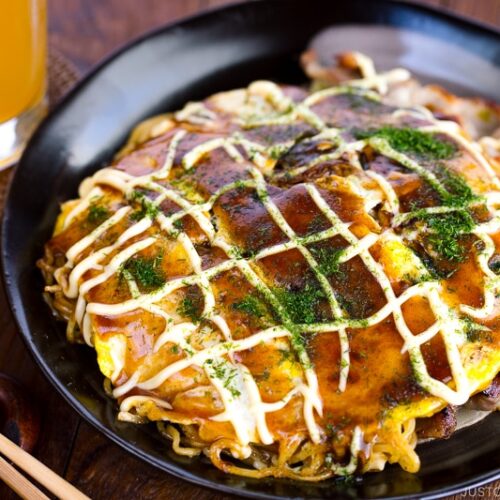
Hiroshima-style Okonomiyaki
Video
Ingredients
For the Batter
- 150 ml water (⅔ cup minus 2 tsp)
- 1 tsp mirin
- 100 g cake flour (¾ cup + 1½ Tbsp; you can make homemade cake flour; or substitute all-purpose flour in a pinch)
For the Okonomiyaki Layers
- 8.5 oz green cabbage (about 3 large cabbage leaves)
- 1 green onion/scallion
- 2 Tbsp katsuobushi (dried bonito flakes)
- 4 Tbsp tenkasu/agedama (tempura scraps) (12 g)
- 2 oz bean sprouts (about 1 handful)
- 2 Tbsp tororo kombu (dried kelp shavings; you can buy it online; optional)
- 6 pieces sliced pork belly
- 2 servings yakisoba noodles (pre-steamed; about 11 oz, 310 g)
- 2 large eggs (50 g each w/o shell)
- okonomiyaki sauce (you can make my homemade okonomiyaki sauce recipe)
- toppings of your choice (typically aonori (dried green laver seaweed), pickled red ginger (beni shoga or kizami beni shoga), and Japanese Kewpie mayonnaise)
Instructions
- Gather all the ingredients.

- In a large bowl, add 150 ml water (⅔ cup minus 2 tsp) and 1 tsp mirin.

- Add 100 g cake flour (¾ cup + 1½ Tbsp) and whisk until combined. Chill in the refrigerator for at least 1 hour so the texture becomes smooth.

- Meanwhile, use a sharp knife to cut 8.5 oz green cabbage and 1 green onion/scallion into thin slices.

- Grind 2 Tbsp katsuobushi (dried bonito flakes) in a mortar and pestle to a fine powder.

- After chilling for 1 hour, the batter will become smoother.

To Make the Okonomiyaki
- We will make one Okonomiyaki at a time The ingredients are for 2 pancakes, so divide all the ingredients into 2 portions.
- Heat a large nonstick griddle (I use an electric griddle at home) to 340°F (170°C). Pour ¼ cup batter onto the hot griddle. Immediately spread the batter thinly into a large circle with the back of the ladle, starting at the center and spiraling the batter outward (see the video) to a diameter of 8–9 inches (20–23 cm).

- Now, start layering your ingredients. Sprinkle this “crepe“ with 1 Tbsp ground katsuobushi. Then, scatter a portion of sliced cabbage on top.

- Next, top with 2 Tbsp tenkasu/agedama (tempura scraps), some of the sliced scallion, and 1 oz bean sprouts.

- Add 1 Tbsp tororo kombu on top, if using. Then, add a single layer of 3 pieces thinly sliced pork belly without overlapping.

- Pour 1 Tbsp batter on top (this will act as glue). With two spatulas, one in each hand, carefully pick up the pancake from either side and quickly flip. Turn the heat to 390°F (200°C) to cook the meat. Use the spatula to push the edges of the meat toward the rounded pancake shape. Don’t press down the crepe with the spatula yet (you will do so later). When the meat is no longer pink, turn down the heat to 340°F (170°C) and move the Okonomiyaki to the side. If you are using a frying pan instead of the griddle, heat up a second pan.

- With your hands, loosen 1 serving yakisoba noodles and place them in the open space on the griddle (or the 2nd frying pan). Stir-fry until the noodles are coated with the rendered oil from the meat. Next, drizzle 1–2 Tbsp okonomiyaki sauce on the noodles and toss to coat.

- Form the noodles into a round flat shape similar in size to the crepe. Using the two spatulas, quickly transfer the Okonomiyaki on top of the noodles.

- Heat some neutral oil in the open space and crack 1 large egg. Quickly spread the egg into the same size as the Okonomiyaki.

- Before the egg is completely cooked, place the Okonomiyaki on top of the egg (see the video).

- When the bottom of the egg is cooked, flip the Okonomiyaki for the last time using the two spatulas.

To Serve
- Transfer the okonomiyaki to an individual plate and drizzle with okonomiyaki sauce. Customize with the condiments and toppings of your choice. I recommend drizzling Japanese Kewpie mayonnaise in a zigzag pattern and sprinkling aonori (dried green laver seaweed) on top. Garnish with pickled red ginger (beni shoga or kizami beni shoga), if desired. Serve immediately.

To Store
- You can keep the leftovers in an airtight container and store in the refrigerator for 3 days or in the freezer for a month.





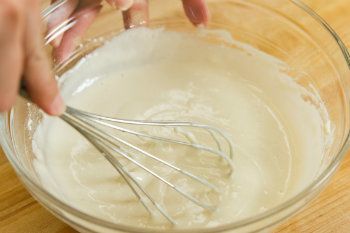

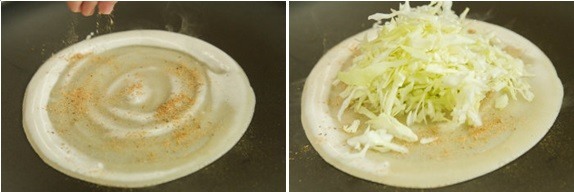


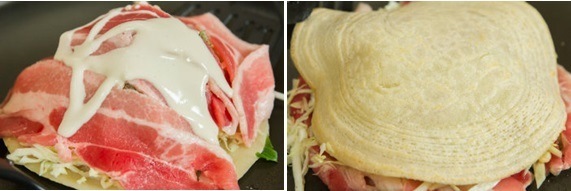



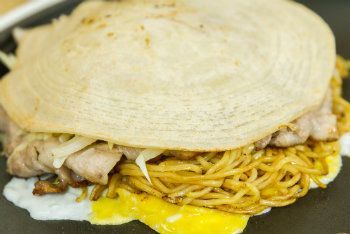
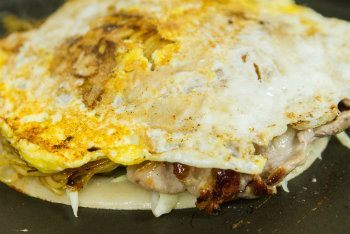











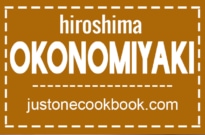
[…] Bean sprouts can be eaten raw or cooked. they can be enjoyed in so many different ways. In Japanese cooking, we love tossing them in salads, topping them on ramen, stir-frying them with other vegetables, or pan-searing them with eggs for okonomiyaki. […]
Quite good. Took a little more time to prepare than I expected (due to no experience). I also may not have measured quite right as the “crepe” was a little thicker than it should have been. It’ll be better next time. Very filling!!!
Hi David! Thank you very much for trying Nami’s recipe!
We hope your next try will be easier than the first time. Happy Cooking!
I made the Hiroshima variety yesterday. I should say tried to make it. 😀
I can’t get pork belly here so I blanched some lightly cured bacon to get rid of some salt and smoke flavor. All was going well until I came step 12 and didn’t increase the heat enough to cook the bacon properly. When I flipped it over it started to fall apart so I didn’t dare try to flip it back. No Okonomiyaki sauce so I used Bulldog sauce. I managed to get it onto a plate nearly in one piece but was tired and hungry and neglected the aonori which I enjoy very much. The recipe is good but Having never eaten it or made it before I was pleased with all the flavors. Would use more katsuobushi next time. Thank you for a fun recipe.
Hi Barbara! Thank you very much for trying Nami’s recipe and for sharing your cooking experience with us!
If you can’t get pork belly, you can try thin sliced pork or beef as well.
We hope your next try will be much easier than the first time! Happy Cooking!
Thanks for sharing your recipes! I really appreciate it to be able to cook and experience authentic food.
I made both Okonomiyaki Versions on two following days for my mum and myself. I have to say, my Mum and I both prefer Hiroshima Okonomiyaki when it comes to taste, the noodles and the egg make the difference. I like the texture of the Osaka version better though, really exciting mouthfeel.
I guess the Osaka Version is also a little better for being warmed up (correct me if I am wrong).
I actually had more problems when trying to flip the Osaka Okonomiyaki, flipping the Hiroshima Version worked a lot better than I guessed it would, maybe thats because I used a pan for the Osaka version and a small iron griddle for the hiroshima version.
Hi Chun! Wow! Thank you very much for trying both versions and for your kind feedback!
Nami and I like both versions of Okonomiyaki, so it’d be tough for us to pick just one! Both versions are delicious, aren’t they?😋
Using a griddle might be easier for flipping Okonomiyaki. If you can flip one kind, we think you can flip both versions. Happy Cooking!
Hi Nami! My family is from Yamaguchi prefecture, very close to Hiroshima, so I am very familiar with Hiroshima-yaki! Can you tell me about how long you cook the crepe (with cabbage/sprouts/pork etc) BEFORE you flip it, and how long you cook it AFTER you flip it? Can’t wait to try this one!
Hi Julia, Thank you very much for trying this recipe! We hope your family enjoys this Hiroshima-Style Okonomiyaki.
If you follow the recipe and the time you get to Step 12, it is the perfect time to flip the Okonomiyaki. The crepe should look dried and not wet batter. After you flip the Okonomiyaki, you have to cook the pork belly until it is no longer pink. It should be about 4~5 minutes, but it’s up to the thickness of your meat, so please check it using spatulas to lift the side of Okonomiyaki.
We hope this helps! 🙂
So delicious, thank you for the recipe!
All the steps are very well explained!
Hi Marie, We are glad to hear you enjoyed this recipe. Thank you very much for your kind feedback!
Thank you for the wonderful recipe. I have been dying to taste okonomiyaki for ages, but there aren’t any restaurants making it in Greece where I live. Just tried it and it was a very, very interesting dish. Served it along with inarizushi and husband liked it a lot. Thanks again!
Hi Efthymia, We are so happy to hear you cook this Okonomiyaki at your home in Greece, and you and your husband enjoyed it! Thank you very much for trying this recipe and for your kind feedback!
Hi Nami and thanks for your amazing blog! I cannot find any proper yakisoba noodles here in German. There are only those yakisoba instant noodle packages. Would you recommend to take those or better to choose different noodles? Maybe udon or chinese style noodles?
Many thanks!
Alex
Hi Alex! Thank you for your kind words! I know, Yakisoba noodles can be so hard to find. 🙁 I would say udon is a bit different so I would prefer to use Chinese noodles. One day I’m going to check what kind of Chinese noodles are similar to Yakisoba noodles and will share my experience. 🙂
Great, thanks 🙂
This recipe was delicious. Although it was a bit on the messy side what with layered ingredients along with the necessity to flip the creation ever so quickly but gently to cook on both sides. With practice I’m sure it will be significantly easier to flip! Next time I shall attempt the Osaka style Okonomiyaki. And I shall come back to this recipe often. I might even try doing a vegetarian version with tempeh.
Hi Patrick! Thank you so much for your kind feedback! Start with a smaller size, which is much easier to flip. Hope you enjoy Osaka version too! Thanks again for writing! xo
I saw a nagaimo at the local asian grocery and on a whim decided to buy it to try this recipe- glad I did!! I followed the recipe mostly (except sub tempura bits for crushed up kids’ crackers and the pickled ginger for yellow pickled daikon). My kids were too picky to eat it – oh well, more pancake for me 😅 I loved it, great fluffy interior and crispy exterior, great density and structure, easy to follow recipe that seems very versatile and flexible. Really great especially with the homemade Okonomiyaki sauce recipe! Thank you so much Nami!!
Hi Brian! Aww I’m so happy to hear you enjoyed this recipe! Thank you so much for your kind feedback. We just had Osaka-style Okonomiyaki last night too. SO good! Ate a bit too much. xD Stay safe and healthy!
This is exactly what my son wanted me to make after seeing some food videos on the YouTube. Thank you.
Hi Joanne! Hope you two enjoy cooking Hiroshima style Okonomiyaki! 🙂
[…] apparently just isn’t so. Hiroshima okonomiyaki is different from its Osaka relative because it has layers. The Osaka version mixes its […]
Can I make okonomiyaki with soba or udon noodles? Do I need to cook them less time and refrigerate them before using
Hi Tania! You “can”, although it’s usually yakisoba noodles. Yes, cook ahead of time and run cold water to stop cooking. Then use it for your okonomiyaki. 🙂
Excellent recipe and instructions. My flipping skills are a little rusty, so I need to practice to better match the flipping shown on the video.
Hi Rob! Thanks for trying this recipe! I’m not good at flipping either… so I try to make small ones so it’s easy to flip. 🙂
[…] Kombu is the shavings of kombu, used to apply around the rice balls or used in Hiroshima-style Okonomiyaki or served as a topping for Udon Noodle […]